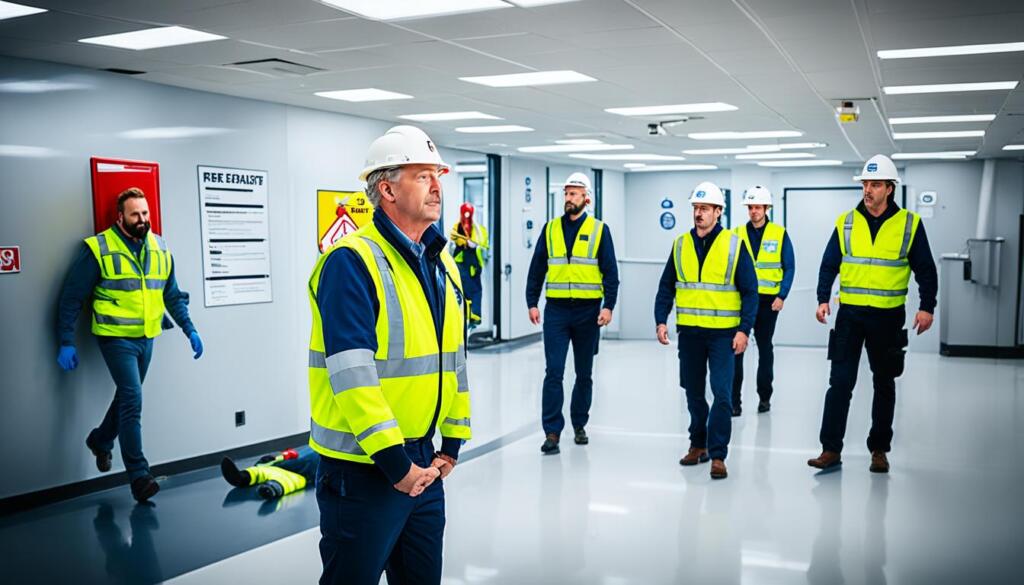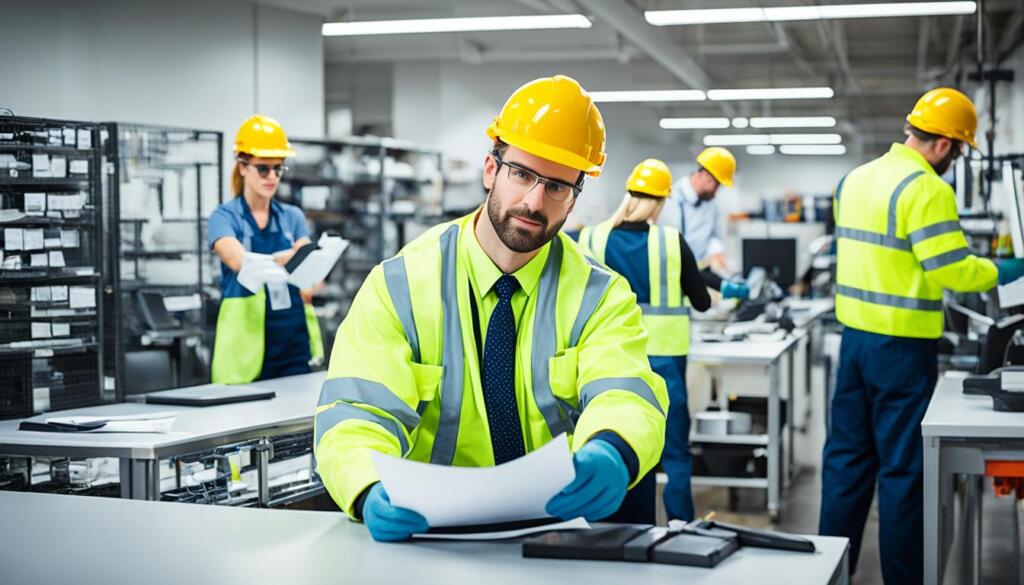Creating a safe environment is key for employees to do their best at work. Employers should set up safety rules to protect their teams. This not only keeps everyone safe but also makes the workplace more efficient. Every boss should train their staff well, make sure they know what to do in an emergency, and stop accidents before they happen.
OSHA warns that workers who are tired could cause accidents. This makes regular breaks crucial for everyone’s safety1. When everyone looks out for each other and helps fix unsafe areas, the workplace becomes safer1. It’s vital that emergency exits stay clear to avoid dangers1. Bosses and workers must team up to follow safety rules and make sure they’re doing everything to be safe1.
Key Takeaways
- Regular breaks are essential for stopping accidents from fatigue.
- By reporting dangers, you help create a better safety culture.
- Clear emergency exits are key to a safe workplace.
- Keeping safe depends on working as a team and following the right steps.
- Use the right posture and lifting methods to prevent harm.
Benefits of Prioritizing Workplace Safety
Keeping the workplace safe is a win-win for everyone. It makes employees and employers happier. Safety at work boosts well-being, cuts costs, and makes people work better.
Improved Health, Safety, and Wellness
Getting serious about safety makes everyone healthier and happier. Most workers want to know the latest safety rules. This helps them feel good. Safety training means fewer injuries and more confident staff2.
Health services also check for risks and set up safety ideas2.
Cost Savings
Safe workplaces save big money. Checking for dangers cuts the chance of accidents. This means paying less for insurance3. Also, fewer sick days and health costs drop thanks to better safety2.
Better Employee-Employer Relations
Safe workspaces make people like each other more. Talking openly about safety helps keep workers happy and staying. Most employees trust their bosses to do safety checks4.
Providing safety gear and talking clearly lead to better work bonds2.
Increased Productivity
A safe place to work means more gets done. Good safety makes workers feel good and work harder3. Happy employees work better in a clean, safe spot2.
Using tools like ‘Distance Assistant’ and ‘Kronos Employee Contact Tracing’ keep the workplace secure. This helps everyone focus and work better4.
Importance of Workplace Safety Culture
Today’s work world moves quickly. Creating a solid safety culture at work is key. It doesn’t just follow safety rules. It also encourages looking ahead for better safety steps. This makes the whole organization better and safer.
Developing a Safety-First Mindset
Having a safety-first mindset is critical. More than 1,850 people died at work in the last ten years. Over 1,140,000 got seriously hurt. This shows how urgent it is to make workplaces safer5.
Management needs to show they put a premium on safety. They set the example. This spreads the message across the company. Caring about quality and teamwork helps build a solid safety culture too5. In places that do this well, people take safety more seriously. They do their safety tasks better5.
Encouraging Open Communication
Good safety starts with talking openly. Employees should feel fine about speaking up on mistakes. This openness helps everyone learn and make things better. In workplaces with great safety vibes, mistakes are lessons. They help make things safer5.
Training and clear rules make sure everyone knows how to stay safe. This makes daily safety a priority.
Rewarding Safe Practices
Encouraging good safety habits with rewards is smart. Things like wearing safety gear without reminders help. So does checking risks before a job. These steps make following safety rules easier5.
Having a strong safety outlook isn’t just for following laws and risks. It boosts how well the company does. It also lifts employee mood. This all keeps costs down from accidents and makes the company look better5.
Hazard Identification and Risk Assessment
It’s critical to spot and assess hazards in the workplace for a safe environment. This step is key to understanding, rating, and lessening risks. It’s all about making sure your workplace is as safe as possible.
Understanding Different Types of Hazards
Workplace hazards fall into several groups like biological, chemical, and physical risks. It also includes ergonomic and psycho-social dangers. Spotting these threats early helps prevent workplace harm6. This knowledge comes from many sources, which give advice on avoiding accidents6.
Steps for Conducting Risk Assessments
To assess risks, you need to follow a few steps:
- First, identify the hazards using monitoring, assessments, and health records6.
- Then, look at the potential harm and chance of it happening. This helps prioritize what to fix first6.
- Next, investigate any past issues or near misses to understand what went wrong6.
- Lastly, review records and reports to see if there are common problems that keep happening6.
Importance of Documentation
Keeping tight records is a big part of spotting and handling risks. Looking over employees’ medical history can show long-term concerns from work, such as sore muscles or damaged hearing6. Notes on these issues help make your workplace safer by focusing on what needs improvement.
Emergency Preparedness & Response
Being ready for emergencies is a big part of keeping everyone safe at work. It’s about making sure employees can deal with different kinds of emergencies. This helps lower risks and protect everyone who is in the work area.
Creating an Emergency Action Plan
Having a strong emergency action plan (EAP) is key to keeping employees safe. It should include plans for natural disasters, severe weather, and more. The plan should go through prevention, preparation, response, and recovery phases7.
Having an emergency team is also crucial. This team will tailor plans to the specific risks of the workplace. Make sure to add safety tips for different emergencies into your plan.

Training Employees for Emergencies
Teaching *safety procedures* to employees is vital for emergencies. Training regularly makes sure everyone knows what to do. It’s important for companies to pass on safety policies so everyone gets it7.
During emergencies, supporting employees with things like full pay and leave is a good idea. This helps keep moral high7.
Conducting Regular Drills
Doing emergency drills often is a must. It helps keep your emergency plans up-to-date. Drills show what parts of the plan might need fixing. This way, employees are well-prepared for the real thing.
Having a strong emergency plan and ongoing training is critical. It ensures the workplace is safe and ready for anything. Make sure to keep safety guidelines updated to boost emergency readiness.
Workplace Safety Tips
Keeping the workplace safe means knowing the rules, paying attention, and always learning about safety. Following these tips makes work safer and more efficient.
Being Aware of Your Surroundings
It’s key to always be alert and know what’s around you. Being aware spots dangers early and lets you act fast. Training helps lower the chance of accidents at work8.
Maintaining Correct Posture
Good posture helps keep your body safe from harm. Having a setup that fits you and lifting things right cuts down on getting hurt. Doing things the safe way is good for your health long term.
Taking Regular Breaks
Having the breaks that OSHA suggests stops you from getting too tired. It helps you stay focused and less stressed, making work better. This also lowers the risk of working too much.
Following Procedures Without Shortcuts
Always stick to safety steps without cutting corners. This stops accidents and makes sure everyone follows the rules. It helps work go smoothly and makes people more likely to point out dangers8.
Keeping Updated with New Safety Procedures
Knowing the latest safety rules helps keep the workplace safe. Learning often and talking about how to handle dangers is a must. This way, everyone can act fast to stay safe8. Having many safety talks also reminds people to think about safety daily8. If you want to learn more, visit workplace safety tips.
Safe Work Practices
Using tools and equipment correctly is key to workplace safety. Employees need to be taught how to use these tools safely. This can stop accidents from happening9.
Taking breaks is important too. Workers who rest reduce the chances of making mistakes because they’re tired. They also lower the risk of accidents due to a lack of focus9.
Learning how to lift things the right way is crucial. It can help avoid back injuries and keep the body healthy. Proper lifting also supports safety at work9.

About 36.5% of work injuries and deaths happen from falls. This shows why keeping the workplace clean and safe is so critical. It prevents slips, trips, and falls9.
Creating a culture that cares about safety is important. This means making sure everyone is always alert. It helps in preventing accidents and injuries at work9.
Teaching new hires about safety is vital. and Keeping them up-to-date on safety practices makes a big difference9.
The Plan, Do, Check, Act system is a great way to keep improving safety. It stops injuries before they happen. Also, it makes your company better by always getting safer9.
For more tips on safety, check out these suggestions. They can help your workplace get even safer9.
Personal Protective Equipment (PPE)
Personal protective equipment (PPE) is key for keeping workers safe in many fields. It shields against dangers that can harm or risk their health. Knowing the different PPE types, how to use them correctly, and why they need regular checks is vital. This makes sure safety standards are followed, fewer accidents happen, and injuries drop.
Types of PPE
PPE includes many safety items like earplugs, hard hats, chemical suits, gloves, and eye wear. They guard workers from loud sounds, falling objects, chemicals, and sharp objects. It’s vital to choose the right PPE for the job to keep everyone safe.
When and How to Use PPE
Using PPE right and at the right times cuts injury risks a lot. For example, OSHA notes that eye injuries cost the U.S. over $300 million yearly. This is a big reason why wearing eye protection at work is crucial. Also, NIOSH found that picking and using PPE correctly can lower injury risk by 60%.
Regular PPE Inspections
Checking PPE often is important to ensure it works well. Broken or old gear might not protect as it should, risking workers. Keeping all PPE in good shape is important for both following safety rules and cutting down on accidents. In the construction sector, falls caused over a third of all deaths10, showing how vital good PPE is.
Following PPE safety rules and keeping gear in great condition makes work safer. Teaching workers the correct way to use PPE and routinely checking its condition protects against dangers. This can lower the risk of accidents at work.
Fire Safety
Fire safety is key in keeping workplaces safe. It all starts with the right training. Keeping up with fire safety training is vital, especially in October, which is fire safety month11.
Importance of Fire Safety Training
Educating workers on workplace fire hazards is a must. They should learn about using fire extinguishers safely. There are many courses available, with over 70 to choose from, making sure everyone knows how to stay safe11.
Maintaining Fire Safety Equipment
Keeping fire safety equipment in top shape is crucial. Fire extinguishers should be inspected every month. Fire alarms and sprinkler systems need regular tests and maintenance. This keeps everything working right all the time11. Doing this establishes a strong safety standard at work.
Emergency Exits and Evacuation Plans
Clearly marking emergency exits is important. It ensures a clear path to safety. Having a detailed plan for evacuation, including where to meet up, improves safety even more11. Being ready for fires this way decreases the danger at work.
Electrical Safety
Keeping safe from electricity at work is crucial. Everyone must know the safety rules and watch out for dangers.
Identifying Electrical Hazards
Spotting dangers means looking for open or active electrical areas. Such zones must be off before any fix can start12. Always think wires are live, especially in risky places12. Barriers should stop you from touching these areas by mistake12.
Proper Use of Electrical Equipment
Being careful with electrical gear is key. When unplugging, grab the plug itself, not the cord, to protect it12. Only experts who know what they’re doing should handle active wires12. It’s vital to follow the safety steps to keep dangers low.
Regular Maintenance and Inspections
Checking and fixing gear helps cut down on risks. Always stay 10 feet away from open wires above you12. Inspections on a schedule find issues early, making the place safer for everyone.
Ergonomics & Injury Prevention
It’s crucial to use good ergonomics and prevent injuries at work. Knowing how to arrange your workspace, lift correctly, and see warning signs can stop injuries. This makes the work environment both safe and efficient.
Setting Up Ergonomic Workspaces
Good ergonomics at work prevent many injuries, especially those in muscles and bones. A proper setup includes chairs that adjust and support your back, desks at the right height, and monitors at eye level. This prevents strain on your neck. These steps really lower the chance of getting hurt, making the workplace a safer place.
Keeping areas clear and making sure tools work well stops falls and burns13.
Proper Lifting Techniques
Lifting items the right way is key to avoid getting hurt. Employees should be taught to use their legs when lifting heavy things. This way, fractures and muscle problems are less likely to happen. Remember, most work accidents come from not lifting safely13. Taking breaks and staying aware of how you work also help keep you healthy and reduce stress on your body.
Recognizing Signs of Strain
It’s important to notice when your body feels off to avoid bigger problems. Everyone should know what these signs are and tell someone right away. This keeps the workplace safe and makes sure people get help early if they need it. The U.S. Bureau of Labor Statistics found 2.8 million nonfatal illnesses and injuries at work in 202213. Checking in often and listening to workers’ thoughts helps make sure safety measures are working well.
For more tips on keeping your workplace safe and comfortable, visit this guide.
Conclusion
Creating solid workplace safety rules is key to a safe and productive job place. It meets laws and shows you care about workers. Often, slips and trips cause many job injuries, which makes being alert around stops essential14.
Using smart safety tips can lower accidents. For example, keeping workspaces clean to avoid dust explosions and making sure workers rest to fight tiredness. Being tired leads to more accidents14, proving safety plans and staying sharp are really important.
Focusing on safety at work boosts both worker happiness and output. It also impresses guests and people interested in your business14. A deep safety culture makes staff feel secure and looked after, boosting their effort and work quality. Always teaching and reminding staff about safety is key to keeping everyone safe and working well.
FAQ
What are some essential workplace safety measures?
Key safety measures involve proper training and using PPE. It’s crucial to keep work areas clean. Also, everyone must follow safety rules to avoid accidents.
How can prioritizing workplace safety benefit an organization?
Improving workplace safety can help employees stay healthy and safe. Fewer accidents save money. It also boosts teamwork and makes work more productive.
What is the importance of developing a safety-first mindset?
Getting everyone to think about safety first is key. It makes workers focus on being safe daily. Talking openly about safety helps spot and fix risks before accidents happen.
How can hazards be effectively identified and assessed in the workplace?
To see and understand risks, do thorough checks. Learn about different hazards. Keep good notes to track and fix dangers well.
What should be included in an emergency action plan?
A good emergency plan needs clear steps for each type of crisis. It should define who does what. And, it must ensure everyone knows what to do through training and drills.
What are some key workplace safety tips?
Important safety tips are: always stay alert. Keep your body in good shape. Take breaks to stay sharp. Stick to safety rules and learn about new ones often.
What are safe work practices?
To stay safe, use tools and machines correctly. Take breaks to avoid strain. Lift things the right way. Keep your space tidy to prevent accidents.
What are the types of PPE and how should they be used?
There’s PPE like earplugs, helmets, and chemical suits. It’s vital employees use the right gear correctly. Regular checks make sure it works well to keep them safe.
Why is fire safety training important?
Learning about fire safety stops fires and guides quick reactions. It’s also key to keep fire gear like alarms in good shape and have clear ways out if there’s a fire.
How can electrical safety be maintained in the workplace?
Making sure the workplace is electrically safe means spotting and fixing hazards. Use electrical stuff in the right way. Regular checks keep everyone safe from shocks and fires.
What role does ergonomics play in preventing workplace injuries?
Ergonomics makes spaces that are less hard on the body. It teaches how to lift safely. By noticing signs of strain early, it makes injuries less likely, especially in the muscles and bones.
Source Links
- https://www.esafety.com/8-workplace-safety-tips-employees-should-know/
- https://www.officefinder.com/officeblog/workplace-safety-inherently-important-employee-well/
- https://www.work-fit.com/blog/4-general-workplace-safety-tips-that-can-benefit-your-company-and-its-employees
- https://www.linkedin.com/pulse/why-employers-who-prioritize-safety-win-war-talent-dan-schawbel
- https://safetydocs.safetyculture.com/blog/safety-as-a-culture-benefits-and-importance-of-safety-culture
- https://www.osha.gov/safety-management/hazard-Identification
- https://eddy.com/hr-encyclopedia/emergency-preparedness-in-the-workplace/
- https://www.alertmedia.com/blog/workplace-safety-tips/
- https://www.ecompliance.com/blog/8-workplace-safety-tips/
- https://www.osha.gov/personal-protective-equipment
- https://www.esafety.com/5-workplace-fire-safety-tips/
- https://www.esafety.com/10-electrical-safety-tips-for-the-workplace/
- https://www.doherty.com/2024/01/25/ensuring-workplace-safety-a-guide-to-preventing-office-injuries-and-illnesses/
- https://www.vectorsolutions.com/resources/blogs/10-daily-workplace-safety-tips-in-manufacturing/


